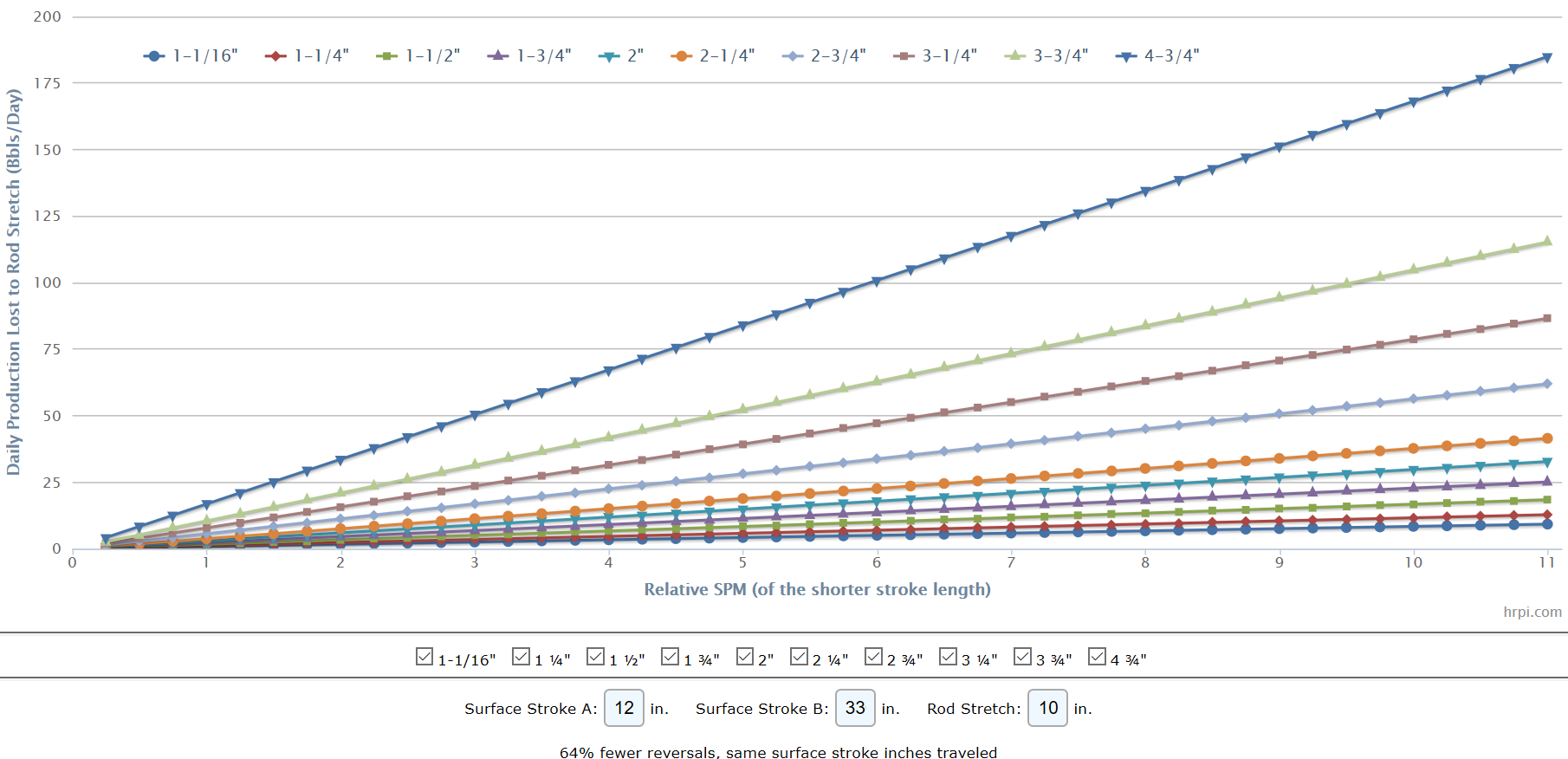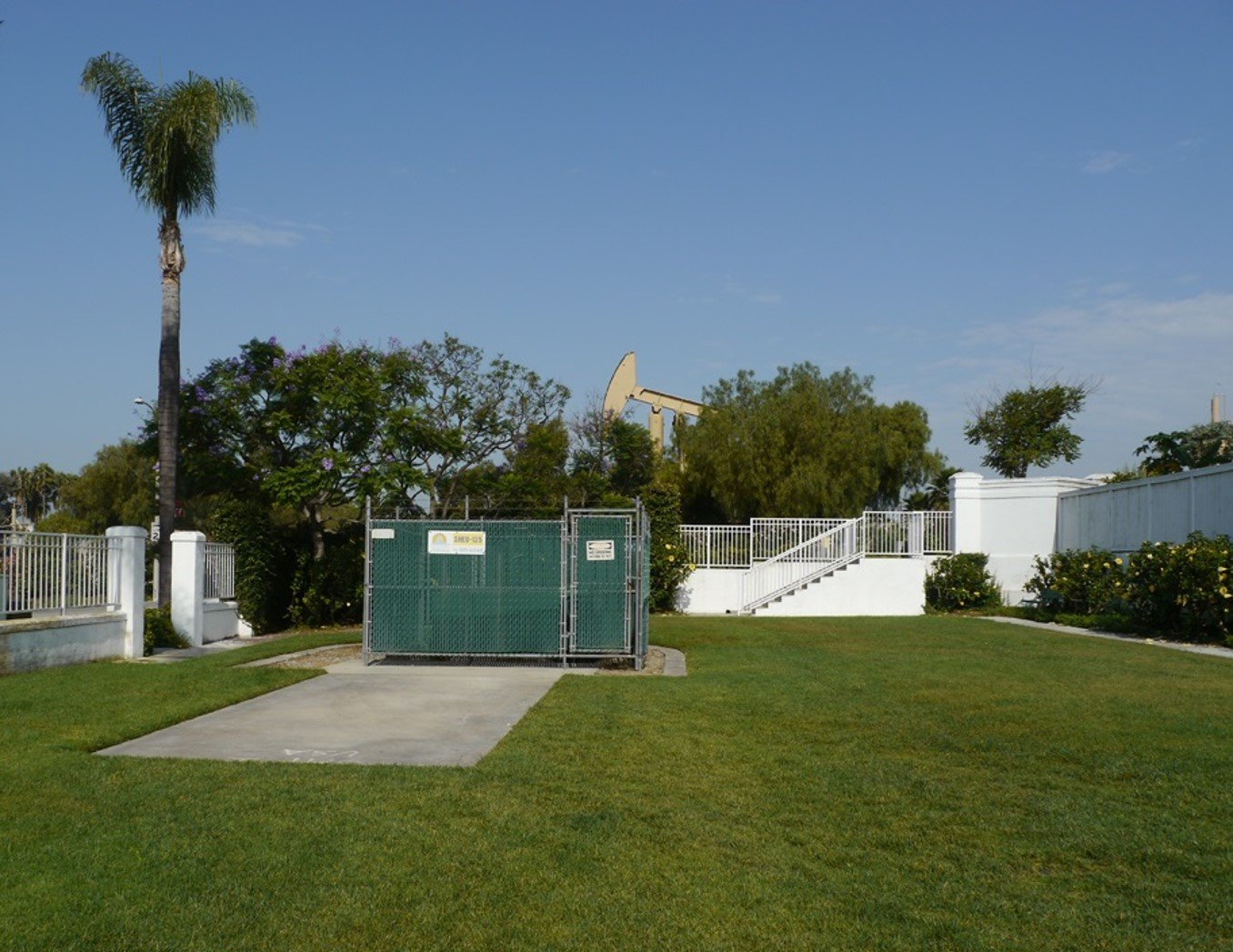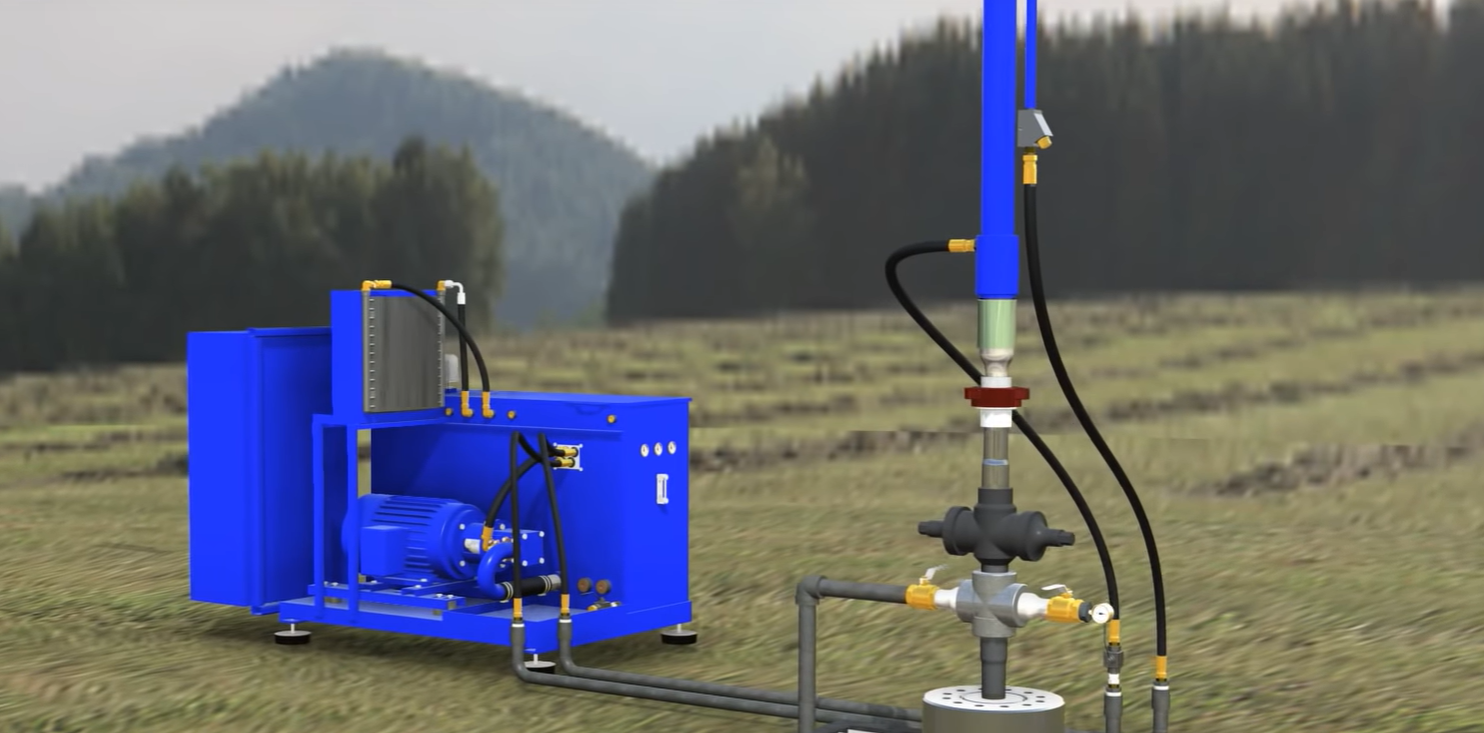HRP Benefit #1Ultra Long Stroke - Up to 336"
Hydraulic Rod Pumps, International (HRPI) manufactures several types of hydraulically actuated sucker rod pumping units for use on oil and gas wells. The most common type of HRP (Hydraulic Rod Pump) currently used throughout the world is an above-ground type, with a tower-mounted hydraulic cylinder (typically possessing a 120” stroke length), and is actuated with a noncounterbalanced power unit.
For purposes of this discussion, the following associations are made between the stroke length of the unit and the category of pumping unit; short stroke=120”, long stroke=240” and ultra-long stroke=336”. While HRPI offers a broad spectrum of pumping unit solutions, this discussion is focused only on comparing the differences between long (or ultra-long) stroke HRP units and short stroke and walking beam pumping units.
Overview of Long and Ultra-Long Stroke HRP Technology and it’s Advantages
Rod pump technology has evolved only slightly in the last three decades with one exception: Long stroke and ultra-long stroke HRP pumping units. The necessity to maximize economical efficiencies of rod-pumped oil and gas wells has created a high demand for longer stroke lengths, as most other elements of the rod-pumped well present little room for improvement. The benefits of long and ultra-long stroke pumping units includes increased production rates, reduced bottomhole equipment wear, decreased rod string fatigue, minimized tubing wear in both vertical and directional wells and lower occurrences of bottomhole pump gas locking. These benefits are discussed below in an overview of applied long stroke and ultra-long stroke pumping technology.
Existing Technology
The vast majority of oil & gas wells in the world are pumped with sucker rods and plunger-type bottomhole pumps. A mechanical drive beam pumping unit, which employs the use of an eccentric crank and crank arms to deliver smooth acceleration & deceleration during stroke reversals, actuates the typical sucker rod pump. This affords a smooth power delivery while converting rotary motion to linear motion.
Sucker rod bottomhole pumps lift fluid during the upstroke and reload the pump barrel during the downstroke, which creates a wide load differential when comparing the upstroke to the downstroke.
Heavy counterbalance weights are used not only to overcome the weight of the rod string but also to even out the load differential, creating a more even power demand throughout the entire pumping cycle.
Higher Efficiencies with Longer Stroke Lengths
Long stroke and ultra-long stroke HRP pumping units perform with higher pump efficiencies than shorter stroke length units due to the surface stroke length to rod stretch ratio. This advantage applies to the total amount of stretch caused by the load differentials (between minimum and maximum polished rod loads), which occurs as a result of lifting the plunger and the weight of the rod string. Each time the upstroke begins, the rod string stretches before the bottomhole plunger begins to lift fluid, effectively losing some of the gross stroke length (measured at surface).
The rod string then contracts during the downstroke (when the plunger load is absent) and re-stretches with the next upstroke. The amount of this stretch divided into the gross stroke length is the loss of efficiency in a calculated straight percentage. For example, a pumping unit with a 120” stroke length actuates a rod string that stretches 12” each time it upstrokes loses 10% efficiency due to stretch. A comparison using a long stroke unit on the same well follows: A 240” stroke unit lifts the same rod string and plunger (with a longer pump barrel to accommodate the longer stroke). The rod string still stretches 12” every time it upstrokes.
The long stroke pumping unit delivers twice the stroke length (240” at surface). The doubled stroke length now mandates stroking one-half as often to pump the same fluid volume and work (measured in stroke inches per minute). This equates to a 5% efficiency loss, attributable only to rod string stretch. The rod stretch related loss of efficiency becomes increasingly greater on deeper wells, wells with large pump plungers and wells that have rod stretch as a result of rod and tubing friction (such as directional wells).
In summary, the longer stroke pumping unit can deliver 5% more production with the same “inches per minute” traveling speed as the short stroke unit, by spending more time lifting the plunger, as opposed to stretching the rod string.
Reducing Bottomhole Equipment Wear
Referring to the above comparative example, the longer stroke HRP pumping unit was slowed to one-half the number of cycles (strokes) per minute, to produce the same volume as the short stroke pumping unit.
With the well now running at one-half the SPM (strokes per minute), the traveling and standing valves in the bottomhole pump are now cycled only half as often as before. The valves in a bottomhole pump are often the primary cause of pulling jobs due to low pump efficiency, attributable to cyclical wear.
These types of failures are largely relative to the number of cycles, as opposed to the amount of fluid pumped. This is due to the type of valves deployed in pumps, which are subjected to a metal-to-metal impact each and every time the valves close.
By reducing the number of cycles per minute by 50%, the pump life expectancy is theoretically doubled by using the long stroke pumping unit.
Reducing Rod String Fatigue
Despite delivering smooth power to the rod string during reversals, the mechanical beam pumping unit’s sinusoidal acceleration and deceleration causes unwarranted fatigue on the rod string. The acceleration during the beginning of the downstroke on a beam pumping unit often drops the upper portion of the rod string downward faster than the middle or lower rod string will fall, causing rod string compression. This can be caused by a number reasons, including (but not limited to); fluid resistance against the plunger (from fluid viscosity or gas locking), rod friction (caused by lateral side loading of the rods against the tubing), hydraulic resistance of fluid passing around rod couplings and rod guides, or simply attempting to downstroke faster than the rods will fall in fluid.
Conversely, the acceleration during the beginning of the upstroke causes higher than ideal peak stresses on the rod string by quickly accelerating a mass (the rod string). In addition, it has been documented that tremendous peak stresses directly above the pump (at the bottom of the rod string) can also be much greater than predicted and/or expected from the surface when larger bottomhole pump sizes are used. This is caused by resistance against the plunger imposed by fluid friction (attempting to accelerate around rod couplings) during the acceleration phase of the upstroke, and often leads to unexplained or misdiagnosed rod body failures above the pump.
These abnormal loads imposed on the rod string typically manifest themselves in the form of measurable dynamic waveforms, and appear (in graphical form) as a sine wave component within a dynamometer card. It is often referred to as the “rubber-band effect”, as it is based on a rod string’s modulus of elasticity and can be described as a “weight” hanging on rubber-band (where the rod string and plunger comprise the “weight” and the rod string is the rubber-band). The energy created by the abnormal loads repeatedly stretches and contracts (diminishing in magnitude with each cycle) until the energy is dissipated.
Rod string fatigue and subsequent premature failure occurs when the rod string is loaded and unloaded cyclically under abnormal (or extreme) loads. The predicted metallurgical life expectancy of a sucker rod string is based on the absence of compression loads (as well as other detrimental environmental factors) and is theoretically infinite providing safe tension loads are not exceeded (according to the modified Goodman diagram). Whenever abnormal outside forces are introduced (such as compression, corrosion or stress risers), the modified Goodman diagram no longer applies (as the results become unpredictable) and rod string life expectancy is cut drastically shorter. The imposition of abnormal dynamic loads generated by accelerating and decelerating the rod string can drastically decrease the life expectancy of rod strings by exceeding the safe metallurgical load limits under tension (during the upstroke) or compression (during the downstroke). The negative effects of these adverse loads are also magnified when operating in hostile conditions. Varying pump loads (due to fluid level fluctuations), fluid viscosity changes, well bore deviations, sudden speed changes (such as sticking pumps), temperature changes, the presence of corrosives, the fluctuating presence of gas, tubing movement, etc. all serve to adversely affect the metallurgical stability and life expectancy of sucker rods.
Long stroke and ultra-long stroke HRP pumping units were conceived out of a clear understanding of current beam unit and rod string dynamics (and drawbacks), as well as what ideal dynamics for rod and tubing strings should be like. Long stroke hydraulic and mechanical pumping units (such as the Rotoflex) have the same designated purpose: To provide longer, smoother, strokes with linear traveling speeds. Linear traveling speeds drastically reduce the dynamic wave-form load conditions (rubber-band effect) by accelerating to a slower fixed rate and holding a constant rate for the duration of the stroke. This reduces the magnitude of the momentum-reversal-generated energy and allows it to dissipate quickly, drastically reducing rod compression and acceleration-generated higher stresses.
Minimizing Rod and Tubing Wear
Rod compression causes several different problems, one of which is rod fatigue and subsequent premature failure. The second problem is two-fold: Rod and tubing wear. Most cases of rod string compression cause the rods to buckle inside the tubing. This lateral movement creates unnecessary contact between the rods and tubing, which results in tubing and rod wear. Tubing wear is often more prominent (and more costly to repair) because it results in tubing string pressure failures (splits). Rod body wear is often overlooked as an indicator of possible string compression and is usually not properly evaluated during a workover unless extreme wear is present. The worn condition is also commonly dismissed as “acceptable” wear since the lower portion of the rod string is less likely to fail (where rods are not subjected to high stresses). The effects of rod string compression are expensive and unnecessary, and can be greatly reduced when long stroke units are utilized.
Long stroke and ultra-long stroke HRP pumping units reduce rod and tubing wear by two methods. The first is explained above, by reducing acceleration and maximum speeds, and by using a fixed traveling speed. The second is by distributing wear patterns over larger areas (or longer distances). Most rod strings are screwed together with rod couplings. The coupling has a higher profile (larger OD) than the rod body, which forces it to contact the tubing before the body of the rod makes contact. This forces any side loads to be distributed with a high concentration of force on a very small area (the length of the coupling only). This concentrated lateral force travels up and down the tubing only the distance of the stroke length, creating a wear pattern inside the tubing string. The longer the stroke length, the larger the area (or longer linear distance) the wear pattern can be distributed. With a 120” stroke length and rod couplings evenly spaced every 30 feet, the tubing experiences only a 120” long wear pattern from the coupling traveling inside. This leave 240” of un-swept distance in the tubing, or 66.6% of the tubing unworn. A long stroke unit (240”) will effectively distribute the wear over twice the area (distance), leaving only 33.3% of the tubing unworn. This wear pattern enhancement greatly extends the life of the tubing, reducing costly tubing string failures.
Reduced Gas Locking Problems
Gas locking occurs when the traveling valve (inside the bottomhole plunger) fails to open to reload the pump, due to the absence (or deficiency) of fluid below the plunger (in the pump barrel). The traveling valve relies on the presence of fluid below the plunger to provide pressure during the downstroke to force the valve open. Wells that produce moderate to high concentrations of gas (or liquids able to form gas under low pressures) are likely to have gas-locking problems.
This includes steam flood, CO2 flood and wells that operate at or near a pumped-off condition. Gas locking can be reduced by spacing the pump plunger close to tapping down with each stroke (a condition where the plunger mechanically hits the bottom of stroke) however, this does not eliminate it or prevent it. The practice of spacing pumps very close to tapping down creates a higher likelihood of damaging either the bottomhole pump, pump shoe (seating ring), standing valve, or standing valve retrieval (on-off) tool. In addition, the practice of tapping a pump down can severely damage to the rod string due to the extreme state of compression.
Spacing a plunger close to tap down is done to reduce the un-swept area below the plunger, effectively increasing the pump’s compression ratio. The compression ratio of a pump dictates how much pressure can be built up below the plunger to assist in opening the traveling valve. Longer strokes and larger pump diameters also increase the pump compression ratios and help to reduce gas-locking problems. Long and ultra-long stroke pumping units help increase well productivity by reducing the frequency and likelihood of gas locking, thereby helping wells remain pumped down longer (reducing annulus back pressure against the formation).
Summary
The benefits of long and ultra-long stroke HRP units have only been briefly discussed here and have focused solely on the downhole aspects for operational comparisons. Long and ultra-long stroke HRP units provide substantial long-term cost savings (as compared to short-stroke and beam pumping units), by actuating the rods in a manner close to the ideal model for proper sucker rod dynamics. Long stroke and ultra-long stroke HRP units can deliver superior efficiencies, reduced rod and tubing wear, longer bottomhole pump runs and better production rates than short stroke and beam pumping units.
A more comprehensive discussion of other technical aspects including surface unit options, elimination of stuffing boxes, independent up and down stroke traveling speeds, variable stroke lengths, computer controls (such as automatic pump-off and tapping down on demand), is available upon request.





